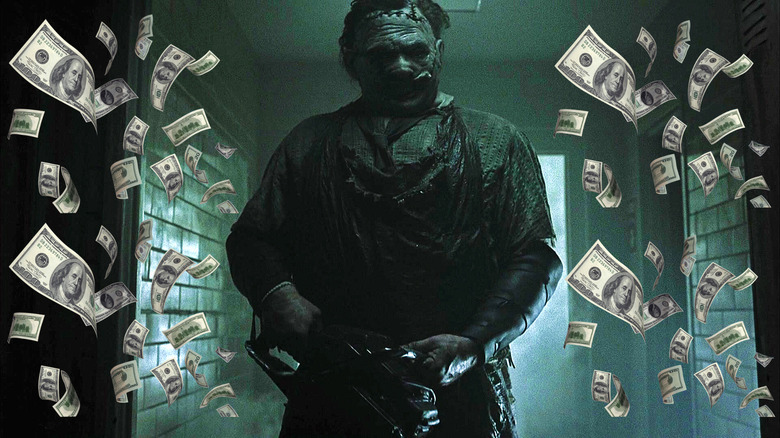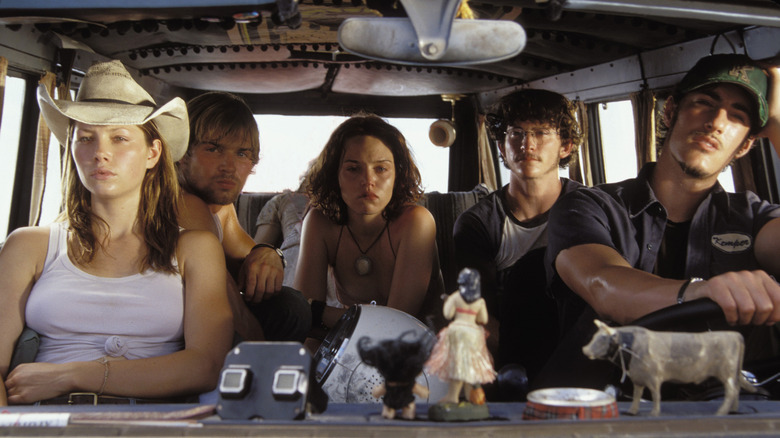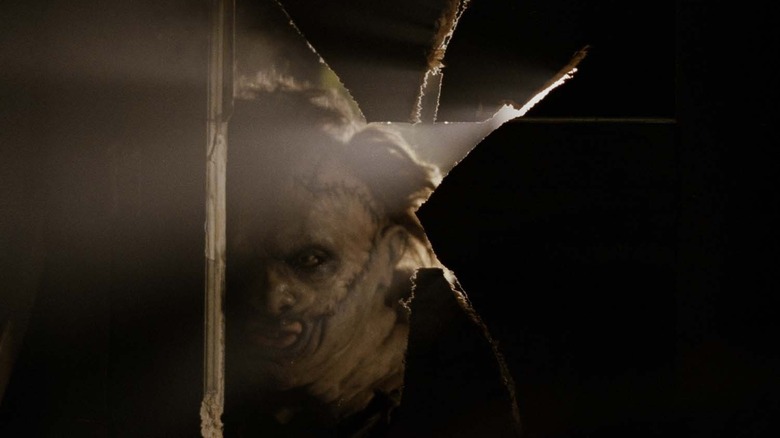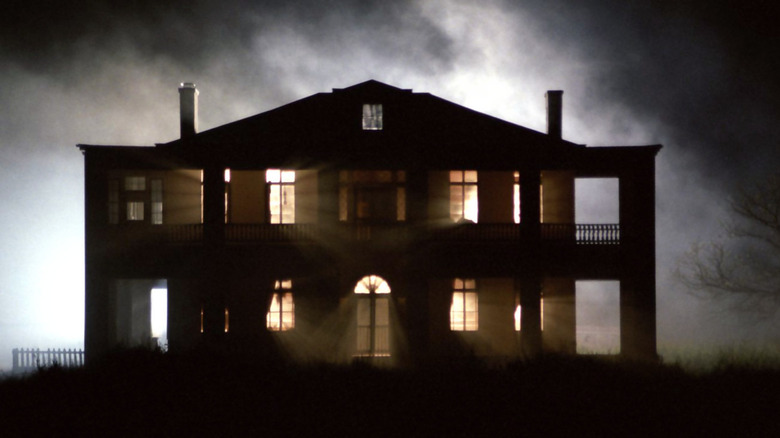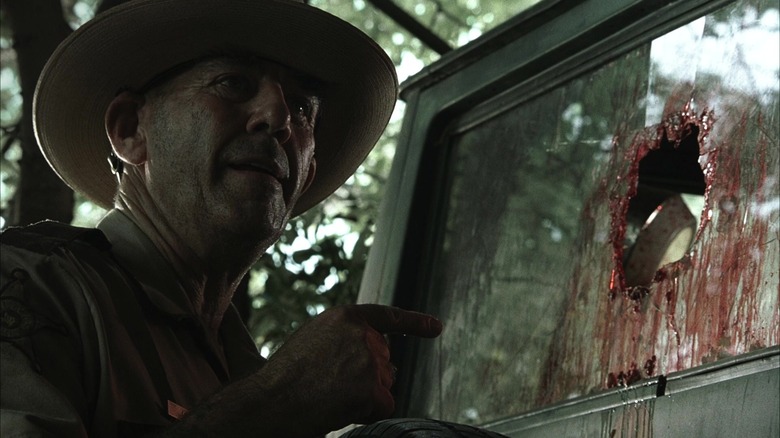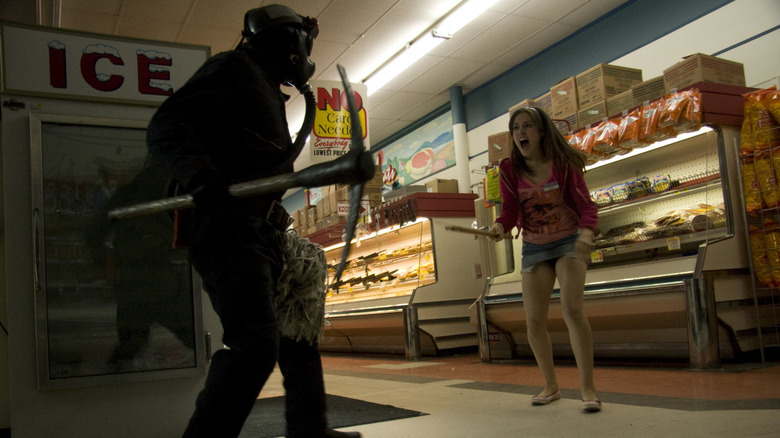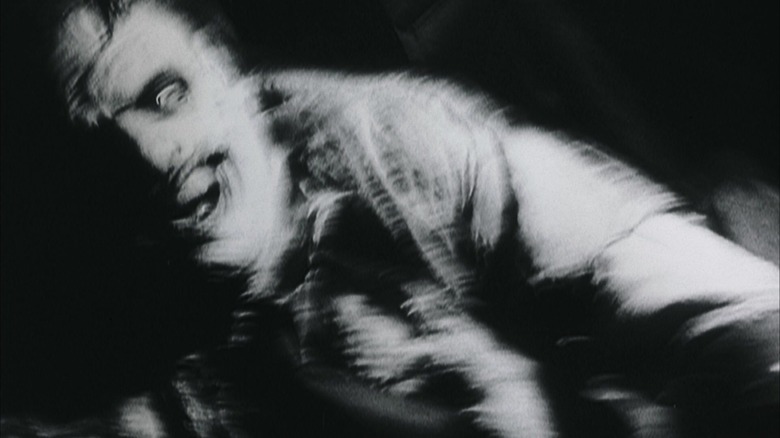2003's Texas Chainsaw Massacre Was A Box Office Hit That Ushered In The Slasher Remake Craze
(Welcome to Tales from the Box Office, our column that examines box office miracles, disasters, and everything in between, as well as what we can learn from them.)
Director Tobe Hooper's 1974 low-budget feature "The Texas Chain Saw Massacre" is not just loved by those who embrace the horror genre; it's one of the most cherished examples of truly independent cinema ever produced. Made for just tens of thousands of dollars, Hooper's film birthed a horror legend for the ages in Leatherface, as well as a franchise that is actually still going to this day. That franchise would hit its apex in 2003 with a gritty, bigger-budget remake of Hooper's iconic classic.
Oddly enough, it was "Armageddon" and "Bad Boys" director Michael Bay who got the ball rolling on "The Texas Chain Saw Massacre" remake, a movie that might have seemed like sacrilege for those who cherished the original. But Hollywood cares not for preserving what came before when there is money to be made and, in this case, there was an awful lot of money to be made. Particularly for Bay and his then-newly-launched production company Platinum Dunes.
In this week's Tales from the Box Office, in honor of the 20th anniversary of 2003's "The Texas Chainsaw Massacre," we're looking back at the film, how it came to be, what happened when it hit theaters, how it spawned a string of similar remakes of horror classics, and what lessons we can learn from it two decades later. Let's dig in, shall we?
The movie: The Texas Chainsaw Massacre (2003)
After suffering a pretty hefty defeat with 2001's "Pearl Harbor" – a critical disaster – Bay decided to swing wildly in the other direction. Yes, he would go on to direct many more big-budget films, including five "Transformers" movies, but he launched Platinum Dunes later that year with the aim of making cheap films that had big upside potential. Speaking to Variety in 2001, Bay Explained:
"After 'Pearl Harbor,' I wanted to do some different things with my life. I wanted to take a bit of time away from the big movies and get some other things going. These films will be done on the cheap ... We don't want to do a lot of pictures, no more than a couple a year ... these small films have a lot of profit potential. You can make them for $5 million, and if they have two good weekends, they're wildly profitable."
The company's first venture? Remaking "The Texas Chain Saw Massacre." News of the remake spread like wildfire in certain corners of the internet at the time. Rumors suggested the film would be told via flashback from the perspective of Sally Hardesty, played in the original by Marilyn Burns. That proved not to be the case. Speaking to Cinescape in 2001, Hooper explained that he wasn't really involved in the remake:
"I didn't have to sign off on it. I'm involved kind of peripherally ... I don't have the slightest idea of what I'm going to see. I hope it is interesting. The times seem to be right for it. I think it's a matter of if they dig up enough of the spirit of these crazy times we're in because really that's what 'Chain Saw' was and is. The original bubbled up out of its times and in these times, as far as that goes, are far richer and deeper with horror than back then. We'll see. You have to throw a net over a spirit that you hope you conjure up."
'Leatherface is back'
Hooper also added, "It is different. I don't think they're doing shot-by-shot or anything like that. I do know they're in prep and they've found locations and there will be a house," before adding, "Leatherface is back." Naturally, the idea was to bring back the chainsaw-wielding maniac for a new generation. One can't reasonably make a "Nightmare on Elm Street" movie without Freddy Krueger or a "Halloween" movie without Michael Myers (save for "Halloween III: Season of the Witch").
Someone was going to have to fill the shoes that Gunnar Hanson famously filled in Hooper's original film. Ultimately, hulking actor Andrew Bryniarski became the man to carry on Leatherface's legacy in director Marcus Nispel's feature directorial debut. But Bryniarski wasn't originally pegged as the man for the job, even if he desperately wanted the job. Speaking with TexasChainsawMassacre.net, the actor explained how he found his way to the role:
"I asked Michael Bay if I could play Leatherface the same week it was announced he was making the movie. We had worked together on 'Pearl Harbor' and stayed friendly [...] Marcus wanted the biggest guy. Later we find out some guy [Brett Wagner] lied about his size and physical ability in a big way. They hired the wrong guy and then on day one, scene one, take one, he is hospitalized/disabled by the intensity of work and is fired. By now they needed help ... and I was raring to roar. I was then asked if I could/would still like to fly to Austin. I told Marcus 'Don't worry I'm your man, I was born to wear the mask!' I meant it. He knew it. That's that."
Once at the beginning, once at the end
2003's "The Texas Chainsaw Massacre," much like the original, centers on a group of young travelers who come across an isolated rural home while driving through Texas. Unfortunately for them, the decrepit house is the residence of a family of deranged backwoods killers who begin to hunt the strander group one by one. Also like the original, it is loosely inspired by the real-life crimes of serial killer Ed Gein.
The film even brings back John Larroquette in his role as the film's narrator to provide some connective tissue. Larroquette would, once again, reprise that role for Netflix's "Texas Chainsaw Massacre" in 2022. Nispel added some found-footage bookends to the film that made it appear as though law enforcement had uncovered video from the scene of the crimes, just to help set the tone for what was to come.
Convincing Nispel to do the film as his first feature was another thing entirely. Interestingly enough, cinematographer Daniel Pearl, who shot the original film in '74, returned for the remake. He was the one who convinced Nispel to do it. Speaking to Starburst in 2015, the director explained:
"I said, 'Daniel, this is blasphemy. They're remaking your movie and they'll screw it up!' And he says, 'Well you've got to direct it.' I asked him why and he said, 'If you're going to direct it, you're gonna hire me and I'm gonna make the same movie twice. Once at the beginning of my career and once at the end of my career ...' So I was like, 'F**k it! Let's just do it, let's go for it.'"
Went for it they did. Filming took place in Austin, Texas, in 2002, staying true to the roots of the original. Armed with a cast of up-and-coming young actors such as Jessica Biel ("7th Heaven") and Jonathan Tucker ("The Virgin Suicides"), as well as sturdy character actors like R. Lee Ermey ("Full Metal Jacket"), Nispel didn't just craft a hit movie — he helped kickstart an entire movement within the horror genre.
The financial journey
It should be understood that — save for Hooper's original – this is not a franchise that had seen widespread commercial success up to this point. The previous entry, "Texas Chainsaw Massacre: The Next Generation" (one of Matthew McConaughey's earliest films) hardly registered commercially. But Bay knows how to sell a movie and, with New Line Cinema on board to distribute, this $9 million, R-rated, uncompromisingly brutal horror flick was ready to change that.
Released just in time for the Halloween season on October 17, 2003, "The Texas Chainsaw Massacre" was an instant success, pulling in $29.1 million domestically on its opening weekend in theaters. It handily topped the charts, beating out "Kill Bill Vol. 1" in its second weekend, and "Runaway Jury," which probably felt like the safer bet at the time. They were no match for Leatherface. It didn't matter that critics of the day were unkind (the film holds a 37% approval rating on Rotten Tomatoes). Audiences were resoundingly onboard for the backroads ultra-violence that Nispel had cooked up.
The remake finished with $80.5 million domestically to go with $27.3 million internationally for a grand total of $107.9 million globally. It was a high that the franchise would never again touch. 2006's "The Texas Chainsaw Massacre: The Beginning" made just $50.5 million against a $16 million budget, while 2013's "Texas Chainsaw 3D" pulled in just $47.6 million against a $20 million budget. 2017's "Leatherface" was dumped to VOD with very little play in theaters, while 2022's "Texas Chainsaw Massacre" got sold to Netflix.
Be that as it may, the '03 film was a runaway success and its impact was felt almost immediately. Not only was Bay's Platinum Dunes off to a great start commercially, but it signaled to Hollywood that the time was now to revisit some of horror's biggest slasher franchises with a series of similar remakes.
The 2000s slasher remake craze
As Hollywood is wont to do, a series of slasher remakes followed for the next handful of years. Nispel would even direct one of these personally — once again for Platinum Dunes — in the form of 2009's "Friday the 13th" ($92.7 million worldwide/$17 million budget). Platinum Dunes also produced remakes of the cult favorite "The Hitcher" ($25.3 million worldwide/$10 million budget) in 2007 and "A Nightmare on Elm Street" ($117 million worldwide/$35 million budget). But it wasn't just Michael Bay and New Line who capitalized on the craze. Far from it.
Several other examples of this craze at work include 2005's "House of Wax" ($70 million worldwide/$35 million budget), 2008's "Prom Night" ($57.1 million worldwide/$18 million budget), and 2009's "My Bloody Valentine" ($102.3 million worldwide/$14 million budget). Though not a true slasher, 2006's "The Hills Have Eyes" ($70.3 million worldwide/$17 million budget) was absolutely a product of this same craze as well. Given that it was a remake of a Wes Craven film, it's not hard to see how it got lumped in with this commercially-driven slasher revival.
Speaking of Craven, it's remarkable to think that less than a decade before "The Texas Chainsaw Massacre" hit theaters, slasher movies were all but dead theatrically. It was "Scream" that brought the whole thing roaring back to life in 1996, with a string of successful films in the genre that followed. Eventually, that looped back to Tobe Hooper and his unsettling cannibalistic creation from decades prior. As is so often the case, old became new again.
The lessons contained within
One of the first things that stands out to me is how Michael Bay, a guy known for making the biggest of the big movies on the planet, built his production company by making sensibly budgeted horror movies. That all starts with this movie and, without it, we might not have franchises like "The Purge" or "A Quiet Place." Certainly interesting to consider. It is admittedly humorous though that Bay originally pegged these films at costing around $5 million and the budget nearly doubled when all was said and done. Even so, $9 million would hardly cover a catering budget for the movies he directs.
Beyond that, it's worth looking at "The Texas Chainsaw Massacre" itself, 20 years on. Sure, critics of the day weren't having it but, in fairness, many revered horror movies were disregarded by critics upon release. That's nothing new. Case in point, this is a film that has found a tremendous deal of love in the years since its release, perhaps second in the franchise only to Hooper's untouchable original. Nispel may have originally thought of it as "blasphemy" but he made a movie people are still very fond of to this day.
There's a larger point to be made there about remakes in general. Yes, a lot of the remakes of that 2000s era were less-than-great. Cash grabs aren't often a breeding ground for creativity. But remakes can produce truly great results. Just look at John Carpenter's "The Thing" or Zack Snyder's "Dawn of the Dead." Very good things can happen when the filmmakers actually care about the material. Sure, maybe in Hollywood, nothing is sacred. But holding up classics as always untouchable could prevent us from getting the next "Texas Chainsaw Massacre." Remake is not, inherently, a dirty word.
